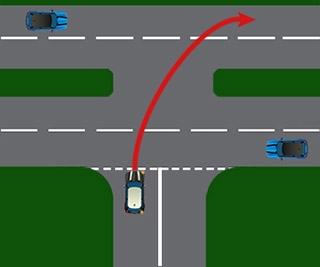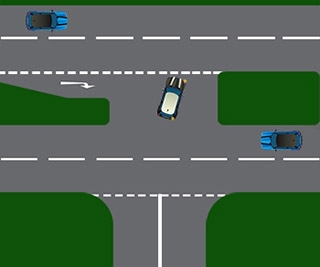Dual Carriageways
The speed limit on a dual carriageway is 70 mph unless otherwise signed.
When using a slip road to join a dual carriageway, don’t take for granted that traffic already on the dual carriageway will make space for you. Always be prepared to use the full length of the slip road and, if you have to, stop and wait at the end of the slip road before pulling out when safe to do so.
The joining clip shows how to use a slip road to join a dual carriageway. Another way is to join a dual carriageway at a normal stop or give-way junction. Here normal rules apply but remember to take into account the higher speed of vehicles on the dual carriageway before moving out.
Right Turns
Unlike on a motorway, on a dual carriageway, it is possible to turn right to either join or leave the dual carriageway. When carrying out a right turn on a dual carriageway, you need to consider the high speed of the traffic and start planning your turn at an early stage.
Check your mirrors carefully, signal well in advance and consider a gentle press on the brakes at an early stage, as this will warn traffic behind you that you are slowing.
Position your vehicle accurately inside the turning bay in the central reserve, and take care to check that the road you are turning on to is clear before pulling out.
If the central reserve is too narrow for you to wait in safely, you should treat the carriageway as one road. When safe, you should cross both carriageways and position yourself in the correct lane.

If the central reserve is too narrow, treat the carriageway as one road.

If the central reserve is wide enough, you can cross the first carriageway and then wait for a suitable gap in the traffic.
Driving on a Dual Carriageway
When driving at high speeds, it is essential you look further ahead than normal. Don’t just look at the rear of the vehicle in front, look as far down the line of traffic as you can. Scan the road ahead to monitor the situation head and make frequent use of your mirrors, so that you know what is happening behind you.
Look for:
- obstructions in your lane
- vehicles ahead slowing down
- vehicles turning through central reserves
- traffic joining the carriageway.
Drive in the left-hand lane. You should only use the right-hand lane for overtaking. If you are overtaking a number of vehicles you should stay in the right-hand lane until you have passed them.
Try to avoid using your brakes unless it proves necessary to do so. Scan the road ahead for brake lights in the distance and as soon as you see any, check your mirrors and ease off the accelerator. This helps traffic flow, and in most cases, you will avoid the need for the brake.
The stopping distance at 70mph is 96m, so the gap you will need to leave between you and the vehicle ahead is substantial. In good conditions, you must keep to the two-second rule.
When approaching slip roads that bring traffic onto the dual carriageway, check that it is safe to move into the right-hand lane, and if it is, do so, as this will create a gap for the vehicle joining the carriageway. If you can not move into the right-hand lane, slow down slightly to create a space in front of you.
Speed limits For Other Types of Vehicles
- 60mph – vehicles towing a trailer or a caravan, coaches and lorries.
- 50mph – a lorry over 7.5 tonnes.
As soon as you see such vehicles ahead you should start planning to overtake them.
For information on how to overtake on a dual carriageway, see our overtaking tutorial.
